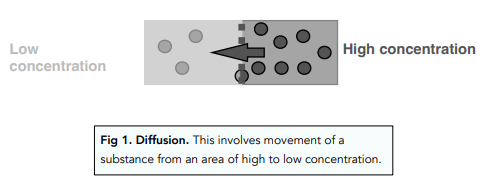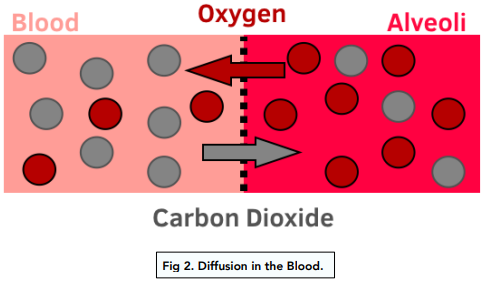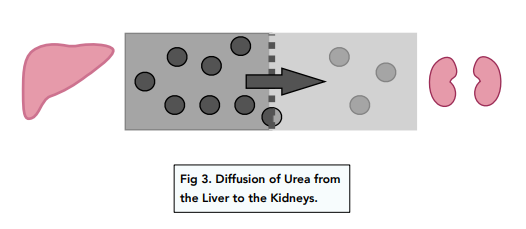Transport in Cells - Diffusion - (GCSE Biology)
Diffusion
Organisms need to take in substances and give out substances. This is known as transport. There are many mechanisms to do this.
We will first look into diffusion.
- Diffusion is the movement of a substance across a cell membrane. Diffusion is the passive movement of a substance in a solution from an area of high concentration to an area of lower concentration.
- Diffusion is passive. Diffusion is passive and so does not require energy. Instead the energy comes from the kinetic energy of random movement of molecules and ions.
- Diffusion occurs in fluids. Diffusion occurs in liquids and gases. Therefore it can occur in the cytoplasm.

- Diffusion occurs in the lungs. Diffusion occurs in the alveoli, as oxygen diffuses from a high concentration in the alveoli into the blood across the capillaries and carbon dioxide diffuses from the blood into the alveoli, along the concentration gradient.

- Diffusion occurs in the kidney and liver. Urea is produced by the liver as a waste product of the body. It diffuses from the liver cells into the blood, from an area of high concentration to an area of low concentration. The urea then goes to the kidneys to be excreted.

Investigating Diffusion in Non-Living Systems
Diffusion can be seen in the following experiment:
- A pH indicator called phenolphthalein turns pink in alkaline solutions and turns colourless in acidic solutions. The colour changes will help us observe the process of diffusion.
- Prepare some agar jelly cubes mixed with the indicator phenolphthalein and sodium hydroxide. This will cause the agar to appear pink.
- Place the cubes in a beaker with dilute hydrochloric acid. Wait for a while.
- You will observe the cubes change colour and eventually go from being pink to colourless. This is because the hydrochloric acid has diffused into the the jelly and neutralised the sodium hydroxide.
Diffusion is a type of passive transport in cells, where substances move from an area of high concentration to an area of low concentration. It is important in transport in cells because it allows for the movement of substances such as oxygen, nutrients, and waste products in and out of cells.
Diffusion works in transport in cells by taking advantage of the natural movement of molecules. In a solution, molecules are constantly moving in random directions. When there is a difference in concentration between two areas, molecules will move from the area of high concentration to the area of low concentration until the concentration is equal.
The rate of diffusion in transport in cells is affected by several factors, including the size of the molecules, the temperature, the concentration gradient, and the permeability of the cell membrane. Smaller molecules diffuse faster than larger molecules, and increasing temperature increases the speed of molecular movement. The concentration gradient, or the difference in concentration between two areas, is also a factor in the rate of diffusion. Finally, the permeability of the cell membrane determines how easily substances can cross the membrane and therefore affects the rate of diffusion.
Diffusion is important for the survival of cells because it allows cells to obtain the nutrients they need and remove waste products. Oxygen and other essential nutrients diffuse into the cell, while waste products diffuse out. Without diffusion, cells would not be able to obtain the necessary materials for survival and would eventually die.
Diffusion and osmosis are both types of passive transport in cells. The main difference between the two is the type of substance being transported. In diffusion, substances move from an area of high concentration to an area of low concentration without the help of a membrane protein. In osmosis, water molecules move from an area of high concentration to an area of low concentration across a selectively permeable membrane.
Cells regulate the transport of substances through diffusion and osmosis by controlling the permeability of their cell membranes. The cell membrane can become more or less permeable to certain substances, allowing for the regulation of the movement of those substances. This is important for maintaining the balance of materials inside and outside the cell, which is necessary for cell survival.
Facilitated diffusion is a type of passive transport in cells that uses membrane proteins to transport substances from an area of high concentration to an area of low concentration. It differs from simple diffusion in that it requires the help of a membrane protein to move the substance across the cell membrane. Unlike simple diffusion, which is limited by the concentration gradient, facilitated diffusion can transport substances against a concentration gradient.
The study of transport in cells and diffusion in biology is important because it helps us understand how cells function and how they are able to obtain the materials they need for survival. It also helps us understand the fundamental principles of biology, including the movement of molecules and the transport of substances across cell membranes. This knowledge is essential for advancing our understanding of biological systems and for developing new technologies and treatments in the future.






Still got a question? Leave a comment
Leave a comment